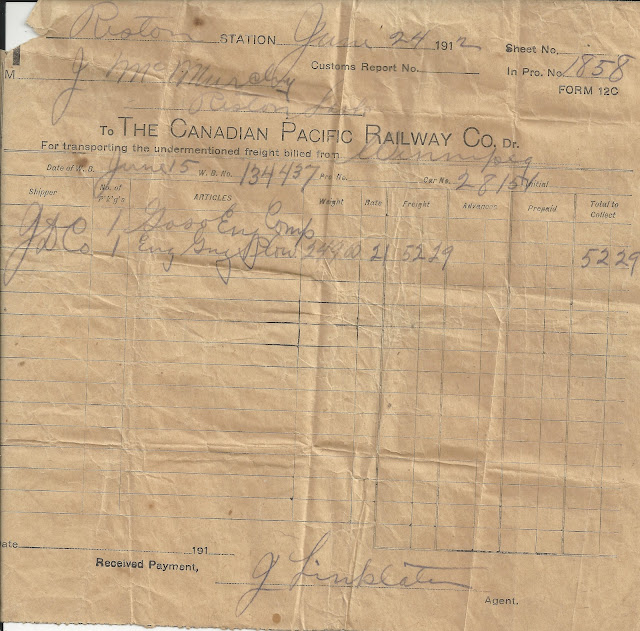 |
| Crowd waiting on the platform at Reston Station - Picture from Reston Museum |
Today's topic reminds me how important trains were to Reston’s early residents. Practically everything they needed and used was delivered to Reston by train - lumber, automobiles, farm machinery, cattle, horses, food, and all manner of supplies. Before the days of truck transportation, it all came by train. Before the highway networks and reliable vehicles, people routinely took the train to visit family, shop in the bigger centres, attend medical appointments, and so much more. Looking at the faces, my favourite picture of all time above, I wonder where they were off to after posing for this picture. Many a homesteader made Reston their final stop with a carload of settler effects and their families to begin a new life here. Reston counted on the railway the same way we see Number Two highway now.
 |
| Postcard from Prairie Towns site dated about 1913 |
In July of 1929, the station house was struck by lightning but by necessity it was quickly put back in service. Two east-west passenger trains arrived and departed every day and at times 18 trains passed through town in a day. Troop trains pulled out of town during both wars with some hometown boys seeing Reston for the last time the day of their departure. Happy reunions with returning soldiers also happened on the station platform for the lucky ones. Reston was also the turn around point for a mixed train on a branch line that left Reston for Wolseley, SK three days a week and returned the next day. This steam train was called The Peanut due to its whistle being reminiscent of that of a peanut vendor on the streets in England. Steam engines were replaced with diesel units as time went on and fewer men were needed to operate this type of machine.
Reston was truly a railroad town and many of its citizens were employed by the industry. Aside from track maintenance crews, railways hired men to keep the water tank full and fill the steam engines, the coal docks were needed to fuel the trains and the Roundhouse had a whole crew of men to service the engines and maintain the huge turntables. The crew to operate the train included the conductor, engineer, fireman and brakeman. I have been contacted by the daughter of Elmer Avery who became the assistant agent in 1926, at the tender age of 18. He would have learned what he needed to know, including Morse code, from his father, James Avery who was the agent at Goodlands Mb for many years. He boarded with a couple named Brown and they remained friends for years after he left Reston (not sure how long he was there). She remembers visiting them in the early 1950s. Thank you, Joan!
 |
| Train Crew in front of station in 1909 |

 |
| CPR 5234 at Reston dated June 1955 - Photo by Bill Hooper on Flickr here |
In researching about the station, Adam David Anderson’s name comes up as being a long serving agent from 1919 to 1954 but also for the kindness shown to many by him and his wife Bertha (Pollock). Known as Dave, he was a talented horticulturalist and the station became a place of beauty and won awards. Dave also had a fur farm where he raised chinchilla rabbits and silver foxes just south the the station house. In retirement, he was involved in the Reston Memorial Park. Other former agents were Joe Cavanaugh, John Linklater (namesake of Linklater siding between Reston and Sinclair), Jack Anderson, George Hooper and the man who locked the door for the final time in 1969, Bruce Marlin.
By the 1960’s change was in the wind when private automobiles and trucking took over the movement of people and goods. The 105 mile Peanut Line to Wolseley was torn up in 1961 and by 1969, there was no longer a need for a station house in Reston. It was demolished in 1969 and the small building left served as a section headquarters and bunkhouse for the railway maintenance crew. My husband Randy worked out of this bunkhouse for a time in his CPR career. It was removed in the 1990’s when Reston was no longer a section territory on its own but combined with a larger one. The two elevators in Reston were deemed too small for the railway to continue to service and were closed in the early 2000's. After this, the railway was still used for grain movement from Redvers. The flood in 2013 took out the track and it was never rebuilt. The track and rails were quietly taken out shortly after, signaling the final days of the train in Reston. Something I'd bet the people on the platform in the picture at the top of this post could not have imagined.











